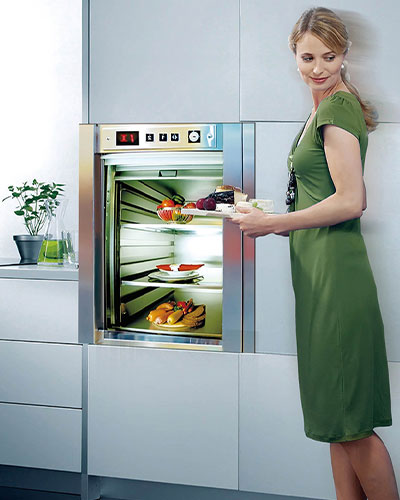With the increasing complexity of modern building and facility management, dumbwaiter elevators are playing an increasingly prominent role in improving logistics efficiency and optimizing space utilization. In addition to the basic vertical transportation function, dumbwaiter elevators are also versatile and can adapt to a variety of different needs. This article will explore the versatility of dumbwaiter elevators and how they can meet multiple needs in various application scenarios, thereby improving overall operational efficiency and service quality.
Dumbwaiter elevators can be designed into different sizes and load capacities according to actual needs to meet various transportation needs. For example, small dumbwaiter elevators are suitable for delivering documents and office supplies, while large dumbwaiter elevators can be used to transport larger volumes of tableware, food ingredients and medical equipment. Through customized design, dumbwaiter elevators can adapt to various logistics tasks to the maximum extent.
In order to adapt to different transport items, various facilities can be configured inside the dumbwaiter elevator, such as anti-slip floors, adjustable partitions, anti-collision guardrails, etc. These configurations not only improve the safety and stability of transportation, but also can be flexibly adjusted according to specific needs to ensure that the items are intact during transportation.
Modern utility lifts are usually equipped with intelligent control systems, with functions such as multi-floor selection, automatic door opening and closing, fault self-checking and remote monitoring. Intelligent control systems not only improve the convenience of operation, but also optimize and adjust according to actual usage, further improving logistics efficiency and safety.

In the hotel and catering industry, utility lifts are mainly used to transport food, beverages and tableware. Through specially designed food-grade materials and internal configurations, utility lifts can maintain the hygiene and safety of transported items. For example, in large hotels, utility lifts between the kitchen and the restaurant can quickly deliver meals to ensure the freshness and taste of food.
Usage lifts can also be used to transport cleaning supplies and bedding in hotel room services. Through reasonable configuration and optimization of transportation routes, utility lifts can greatly improve the efficiency of room cleaning and service and reduce the labor intensity of service personnel.
In hospitals, utility lifts are important tools for the transportation of medicines, medical devices and samples. Through dedicated transport boxes and internal configurations, utility lifts can ensure the safe delivery of medicines and devices, reducing the risk of contamination and damage caused by manual handling.
In office buildings, utility lifts are mainly used to deliver documents, office supplies and express parcels. Intelligent control systems and multi-floor selection functions enable the utility lift to efficiently complete logistics tasks between different floors, reducing the labor intensity and time cost of employees.
With the development of e-commerce, the number of express deliveries and parcels in office buildings continues to increase. By optimizing transportation routes and configurations, utility lifts can efficiently manage and distribute express deliveries and parcels, improving the logistics efficiency of office buildings.
In industrial and warehousing environments, utility lifts are used to transport parts, tools and light products. Through rugged design and multi-functional configuration, utility lifts can adapt to high-frequency use needs in industrial environments and improve production and logistics efficiency.
For the transportation of light products, utility lifts provide an efficient and safe solution. Utility lifts of different sizes and load capacities can meet the transportation needs of various products, reducing the time and cost of manual handling.
With its versatility and flexible adaptation to a variety of needs, utility lifts have become an important equipment in modern building and facility management. By improving work efficiency, improving service quality, saving labor costs and flexibly adapting to a variety of needs, utility lifts have played an important role in many fields such as hotels, hospitals, office buildings, industry and warehousing. Fully understanding and utilizing the versatility of utility lifts can significantly improve the overall efficiency and quality of logistics management and provide strong support for the intelligent and automated management of modern buildings and facilities.











